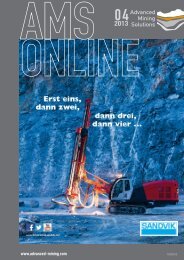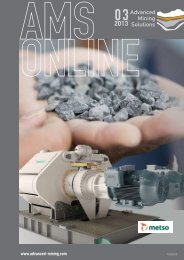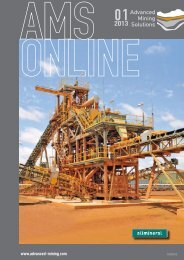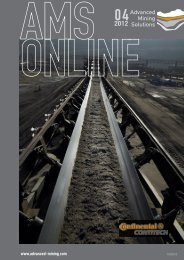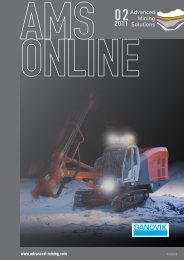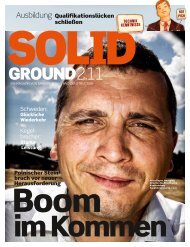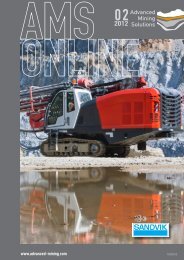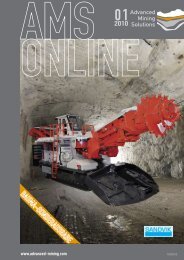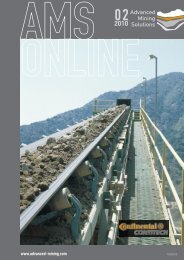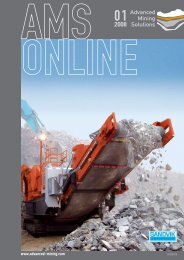A new face drilling rig for narrow tunnels and ... - Advanced Mining
A new face drilling rig for narrow tunnels and ... - Advanced Mining
A new face drilling rig for narrow tunnels and ... - Advanced Mining
Create successful ePaper yourself
Turn your PDF publications into a flip-book with our unique Google optimized e-Paper software.
Results<br />
The results of the test according<br />
to ASTM G 75-07 show major<br />
advantages with spherical carbides,<br />
picture 8. A significant difference<br />
between the broken FTC <strong>and</strong> TC<br />
cannot be determined.<br />
One reason <strong>for</strong> the good results<br />
with spherical carbides lies in the<br />
0<br />
relatively low load, which leads to the<br />
fact that the softer matrix between<br />
the carbides is mostly washed out,<br />
while the carbides themselves are<br />
struck relatively lightly, Picture 9. The spherical carbides<br />
stay longer in the matrix <strong>for</strong>m-closed , since they can only<br />
fall out, in case the matrix is worn out deeper than the<br />
sphere radius. Due to the irregular <strong>for</strong>m <strong>and</strong> distribution<br />
of the broken FTC <strong>and</strong> TC, these can fall out more quickly,<br />
since in this case the supporting effect of the matrix is not<br />
given.<br />
The tests on the material according to ASTM G65-04<br />
very clearly show the different influences, such as grain<br />
size, line pitch <strong>and</strong> type of carbides, picture 10. It becomes<br />
clear that, contrary to the Miller test, the higher contact<br />
pressure of 130 N not only causes the abrasion of the<br />
matrix, but also the demolition of the carbides. In contrast<br />
to the monocrystalline TC, the FTC is lightly dissolved at<br />
the border areas during build-up welding, which enables<br />
a better connection to the matrix material. In addition the<br />
Issue 04 | 2010<br />
Abtrag in mm³<br />
12<br />
10<br />
8<br />
6<br />
4<br />
2<br />
TRANSFER OF TECHNOLOGY<br />
8,80 9,33 7,57 7,79 8,05<br />
9,32<br />
1 2 3 4 5 6<br />
Werkstoff<br />
Pic. 9:<br />
Wear pattern ASTM G75-07 (left: material 3, <strong>rig</strong>ht: material 6)<br />
Pic. 8:<br />
Results of the ASTM G75-07 Millertest<br />
TC is considerably more brittle <strong>and</strong> there<strong>for</strong>e breaks more<br />
quickly. Due to the chosen mass ratio during mixing of the<br />
powder, the coating layer contains less carbides in terms of<br />
numbers with increasing carbide sizes. The influence of the<br />
line pitch is illustrated in material 5, Picture 11. According<br />
to the st<strong>and</strong>ard the quartz s<strong>and</strong> used in the test setup has<br />
a grain size of 200 to 425 µm. Since with Material 5 the line<br />
pitch partly exceeds 200 µm, here the abrasive good can<br />
fully damage the matrix, which leads to an increased drop<br />
out of the FTC spheres.<br />
www.advanced-mining.com<br />
37



